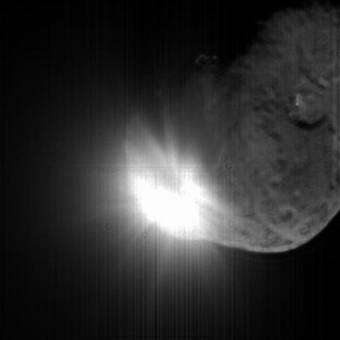Evidence for more dust than ice in comets

Observations of Comet 9P/Tempel 1 made by ESA’s Rosetta spacecraft after the Deep Impact collision suggest that comets are ‘icy dirtballs’, rather than ‘dirty snowballs’ as previously believed.
Image: Ejecta plume from Tempel 1, 13 seconds after impact
Comets spend most of their lifetime in a low-temperature environment far from the Sun. Their relatively unchanged composition carries important information about the origin of the Solar System.
On 4 July this year, the NASA Deep Impact mission sent an ‘impactor’ probe to hit the surface of Comet 9P/Tempel 1 to investigate the interior of a cometary nucleus.
The 370 kg copper impactor hit Comet Tempel 1 with a relative velocity of 10.2 kilometres per second. The collision was expected to generate a crater with a predicted diameter of about 100-125 metres and eject cometary material. It vaporised 4500 tonnes of water, but surprisingly released even more dust.
Tempel 1's icy nucleus, roughly the size of central Paris, is dynamic and volatile. Possibly the impact would also trigger an outburst of dust and gas, and produce a new active area on the comet’s surface.
Just before impact, the Hubble Space Telescope spotted a new jet of dust streaming from the icy comet. No one knows for sure what causes these outbursts.
Rosetta, with its set of very sensitive instruments for cometary investigations, used its capabilities to observe Tempel 1 before, during and after the impact.
At a distance of about 80 million kilometres from the comet, Rosetta was in the most privileged position to observe the event.
European scientists using Rosetta's OSIRIS imaging system observed the comet’s nucleus before and after the impact. OSIRIS comprises a narrow-angle camera (NAC) and a wide-angle camera (WAC). Both cameras imaged the extended dust coma from the impact in different filters.
OSIRIS measured the water vapour content and the cross-section of the dust created by the impact. The scientists could then work out the corresponding dust/ice mass ratio, which is larger than one, suggesting that comets are composed more of dust held together by ice, rather than made of ice comtaminated with dust. Hence, they are now ‘icy dirtballs’ rather than ‘dirty snowballs’ as previously believed.
The scientists did not find evidence of enhanced outburst activity of Comet 9P/Tempel 1 in the days after the impact, suggesting that, in general, impacts of meteoroids are not the cause of cometary outbursts. Scientists also hope to make a 3D reconstruction of the dust cloud around the comet by combining the OSIRIS images with those taken from ground observatories.
Source: ESA

















